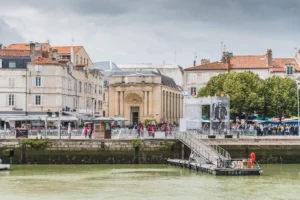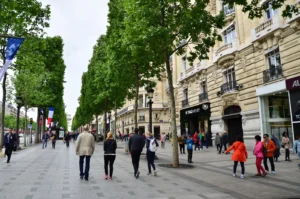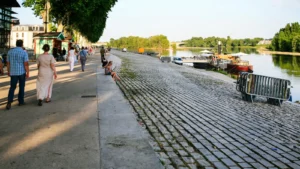Tucked into the hills of southwestern France, Angoulême is a city that wears its personality on its walls. Discovering the best things to do in Angoulême means looking up, around, and often right beneath your feet.
Known as the capital of French comics, this small city punches far above its weight in art, culture, and historical depth. It’s where medieval ramparts overlook winding rivers, Romanesque architecture shares space with bold street art, and café terraces invite slow afternoons.
Angoulême doesn’t shout for attention—it earns it. It offers a rare mix of imagination and authenticity for travelers looking beyond the usual French hotspots.
Best Things to Do in Angoulême for Comic Lovers
Among the most iconic things to do in Angoulême is exploring its deep connection to the world of comic books. For decades, it’s been the beating heart of the French bande dessinée scene, with roots deep enough to attract some of the biggest names in graphic storytelling worldwide.
Cité Internationale de la Bande Dessinée et de l’Image (CIBDI)
The Cité isn’t just a museum—it’s a full cultural complex dedicated to preserving, celebrating, and pushing the boundaries of comic art. Housed in a modern structure overlooking the Charente River, the space includes permanent collections that trace the history of the comic book form, from early French pioneers to contemporary masters.
Temporary exhibitions rotate regularly, often spotlighting international creators or exploring themes like political satire or sci-fi storytelling.
There’s also an exceptional library, a comics-focused cinema, and a bookstore that curates rare editions and international titles. For professionals, the Cité functions as a serious research hub. For everyone else, it’s an invitation into a universe where visuals and narrative collide with creativity.
Fresco Trail – Le Circuit des Murs Peints
Wander through Angoulême, and it quickly becomes clear that the city is one giant open-air gallery. The fresco trail is a self-guided walking route through more than 20 large-scale murals crafted by well-known illustrators and painted directly onto the town’s buildings.
These aren’t quick graffiti tags or decorative touches—they’re immersive, building-sized illustrations referencing famous characters, comic styles, and narrative moments.
What’s remarkable is how seamlessly these works blend with the old architecture. From tucked-away alleys to wide boulevards, the murals feel like they belong. This blend of heritage and pop art gives Angoulême a unique urban character that’s both proud and playful.
Angoulême International Comics Festival
Every January, the city transforms into a creative hive. The Angoulême International Comics Festival (Festival International de la Bande Dessinée) draws over 200,000 visitors and hundreds of artists, publishers, and industry insiders. It’s one of the largest comic festivals in the world, second only to San Diego’s Comic-Con in terms of global relevance.
The festival includes exhibitions, signings, panel discussions, and awards. It’s a once-a-year deep dive into the heart of the medium for aspiring artists and fans alike. But even outside festival season, the energy lingers. Street art, specialty bookstores, and year-round events ensure that comics remain central to the city’s identity.
Top Historical Sights and Things to See in Angoulême
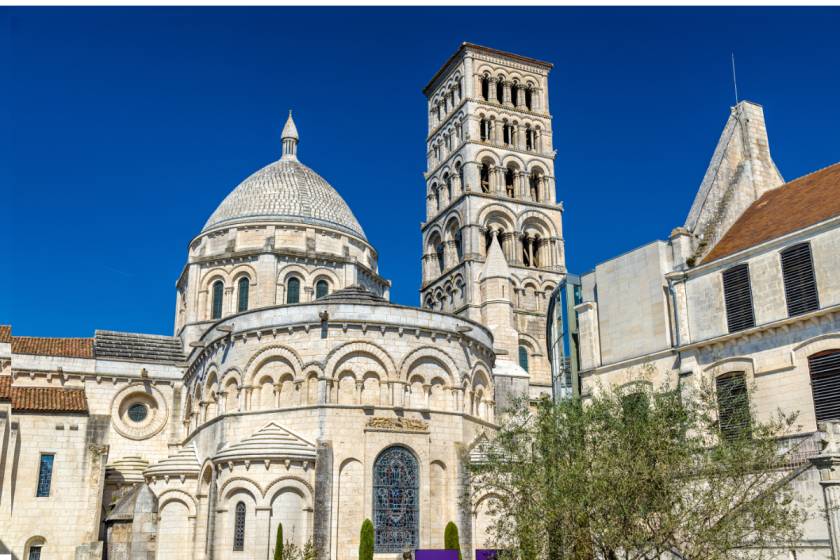
Image from Canva. Saint Peter Cathedral
Beyond its bold street art and creative pulse, Angoulême is layered with centuries-old history. This city is shaped by its strategic hilltop location—once a medieval stronghold, now a living museum of Romanesque architecture, ancient walls, and elegant civic buildings. Exploring its historic sites reveals a quieter, more contemplative side of Angoulême, where stories are told in stone.
Angoulême Cathedral (Cathédrale Saint‑Pierre)
This Romanesque masterpiece, initially built in the 12th century and later renovated in the 19th century, dominates the skyline with its detailed stone façade. The west front is a visual sermon—sculptures of saints, angels, and biblical scenes cover nearly every surface.
Inside, the atmosphere shifts to quiet reverence, with high vaulted ceilings, subtle stained glass, and restored chapels that reflect the region’s layered spiritual history.
The cathedral isn’t just a place of worship—it’s a monument to craftsmanship and continuity. It’s been the spiritual center of Angoulême for over 800 years, and its quiet endurance adds gravity to a town otherwise known for its playful art.
Remparts Walk – Ramparts and Panoramic Views
Walking along the historic ramparts is hard to top for visitors looking for scenic, reflective things to do in Angoulême. The medieval ramparts that once protected the city now serve a more peaceful purpose: they offer one of the most beautiful walking routes in southwestern France. The path runs along the old city walls, providing uninterrupted views over the Charente River and the countryside beyond.
This is where Angoulême slows down even more. Benches and lookout points invite long pauses, while historical plaques detail key moments in the city’s military past. It’s also a great way to grasp the city’s layout, connecting key landmarks like the cathedral, city hall, and museum quarter in one walkable loop.
Hôtel de Ville (City Hall)
Built on the ruins of a former medieval château, Angoulême’s current City Hall blends Gothic and Renaissance architecture with formal French landscaping. The structure is grand but approachable, with turrets, clock towers, and symmetrical gardens that feel more like a noble estate than a municipal building.
Guided visits reveal grand reception halls with painted ceilings and period furnishings. Outside, the surrounding square often hosts open-air art displays or seasonal festivities, turning a civic landmark into a hub of local life. It’s a physical reminder that Angoulême’s past isn’t just preserved—it’s actively lived in.
Dive into Angoulême’s Local Culture
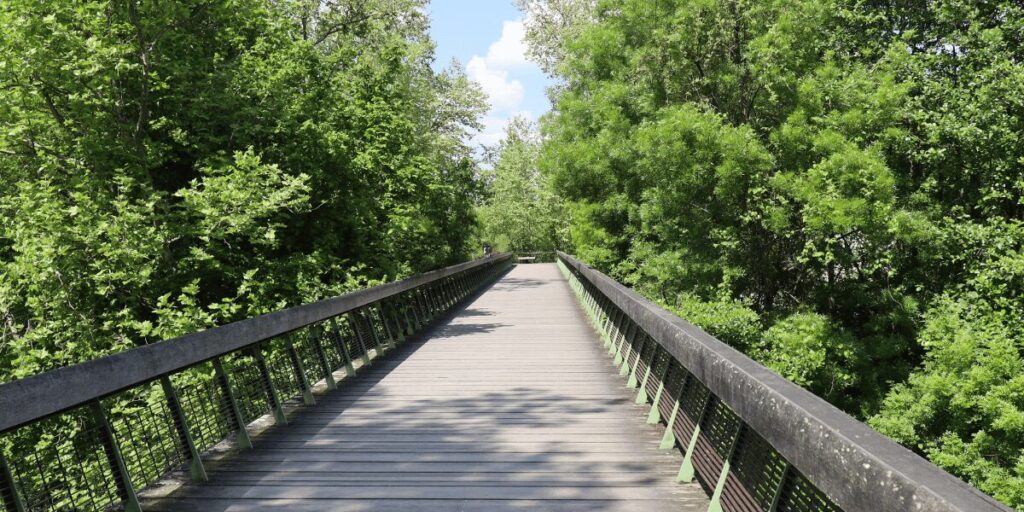
Image from Canva. Foot bridge on Charente River
Angoulême’s cultural identity runs deeper than its famous murals and architecture. It’s a city where tradition and creativity intersect in art galleries and everyday life. Museums, markets, and restored industrial spaces illuminate the region’s heritage and evolving character.
To truly understand Angoulême, step inside these spaces where history, art, and daily rituals quietly meet.
Musée d’Angoulême
Just steps from the cathedral, the Musée d’Angoulême holds one of the region’s richest collections of archaeology, fine art, and ethnography. Housed in a former bishop’s palace, the museum’s elegant, uncluttered layout makes the experience feel expansive rather than overwhelming.
Exhibits trace everything from prehistoric tools in the Charente Valley to medieval sculptures and 19th-century paintings. One standout collection explores the links between Europe and Africa through artifacts acquired during colonial trade, offering rare insight into global history from a local lens.
The museum’s design balances academic depth with approachability, making it a rewarding stop for those curious about how Angoulême fits into broader historical narratives.
Le Nil Paper Mill Museum
This stop offers one of the more surprising and hands-on things to do in Angoulême, especially for those curious about the city’s industrial past.
Long before comics defined the city’s image, Angoulême was known for paper. The Le Nil Paper Mill, once a major industrial site, has been transformed into a museum that honors this legacy. Positioned right on the river, it showcases the traditional papermaking processes with hands-on exhibits, vintage machines, and multimedia presentations.
Visitors can watch demonstrations of pulp being turned into sheets by hand and learn how local mills powered Angoulême’s economy in the 18th and 19th centuries.
It’s a surprisingly engaging experience that connects the dots between old-world industry and today’s creative economy—after all, every comic begins with a blank page.
Les Halles d’Angoulême
To experience the living culture of Angoulême, head straight to the covered market at Les Halles. Open daily, it’s a sensory experience where local producers sell everything from oysters and goat cheese to seasonal fruit and regional charcuterie.
The market hall is a striking structure, built in the late 1800s with iron and glass, echoing the style of Paris’s old Les Halles. Inside, it’s bustling but never chaotic.
Locals linger over coffee, trade recipes with vendors, and browse ingredients with care only found in communities that still prioritize good food and daily ritual. This is where the town’s pace and personality are most evident—slow, flavorful, and grounded.
Where to Eat and Enjoy Café Life in Angoulême
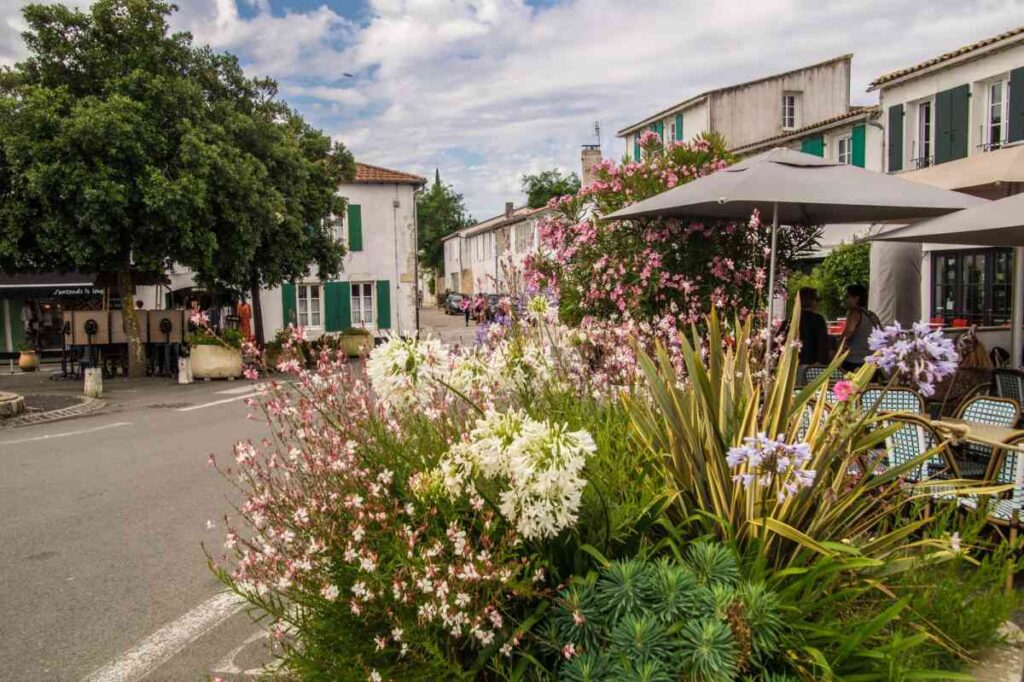
Image from Unlimphotos. Cafe at Angouleme
Angoulême’s charm isn’t limited to what’s on the walls or in its museums—it lives in the rhythm of daily life, which is best felt through its café culture and regional cuisine.
The city’s culinary scene is unpretentious but flavorful, anchored in local ingredients and a strong sense of place. Whether it’s a quiet espresso on a sunlit terrace or a multi-course dinner in a tucked-away bistro, food in Angoulême is both a comfort and a craft.
Café Culture and Atmosphere
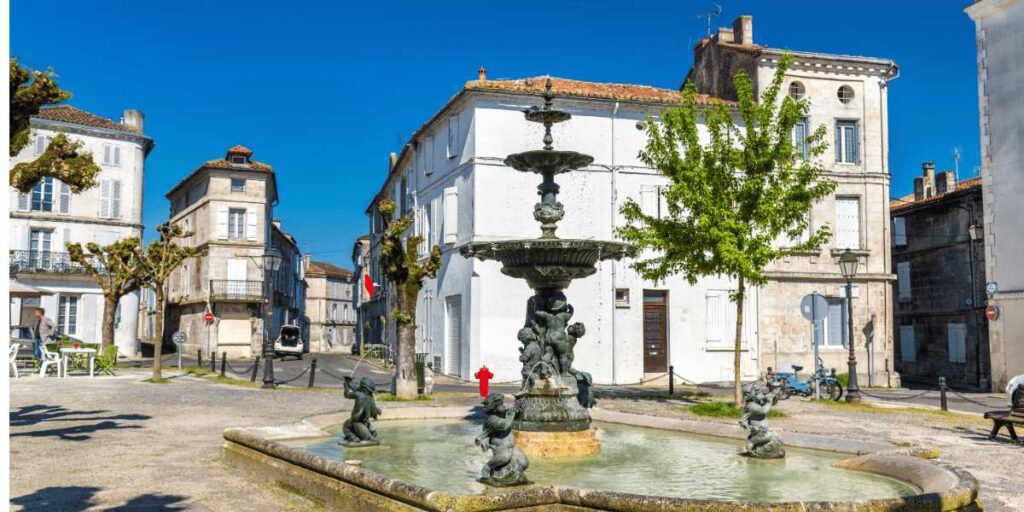
Image from Canva. Fountain at Place du Minage
Cafés in Angoulême are less about quick coffee runs and more about lingering. Tables spill into the streets along Rue Hergé and around Place du Minage, especially in warmer months. Locals read, chat, or simply watch the city unfold—there’s no pressure to rush. Interiors are cozy but often modernized, blending vintage tile floors, minimalist decor, and rotating art on the walls.
These spots function as social anchors. Baristas know regulars by name. Conversation flows as easily as the house wine. And with the city’s creative leanings, it’s common to overhear debates about comic books, cinema, or the latest exhibition. It’s not performance—it’s culture, lived quietly and confidently.
Regional Dishes and Local Specialties
The Charente region offers a menu rich in depth and tradition. Grillon Charentais, a rustic pork pâté, appears on many starter menus, often paired with crusty bread and pickles. Goat cheese from nearby farms adds brightness to salads, while slow-cooked duck or rabbit provides the comfort only French countryside cuisine can deliver.
One standout is Pineau des Charentes, a fortified wine made from Cognac eau-de-vie and grape must. Served chilled as an aperitif, it’s subtly sweet and deeply rooted in local viticulture. Pair it with a cheese plate; the region’s personality comes through every bite.
Dining on Rue des Postes
For a deeper dining experience, Rue des Postes offers several standout bistros where menus change with the seasons. These aren’t flashy spots—they’re warm, thoughtful kitchens run by chefs who value authenticity over theatrics. Expect veal with mushroom cream sauce, caramelized endives, or trout with herbed butter and lentils.
Many of these places source directly from Les Halles, creating a tight loop between local markets and the dinner table. Dining here doesn’t feel like a curated experience—it feels like being invited into something real, something rooted.
Nature, Day Trips, and Outdoor Activities Near Angoulême
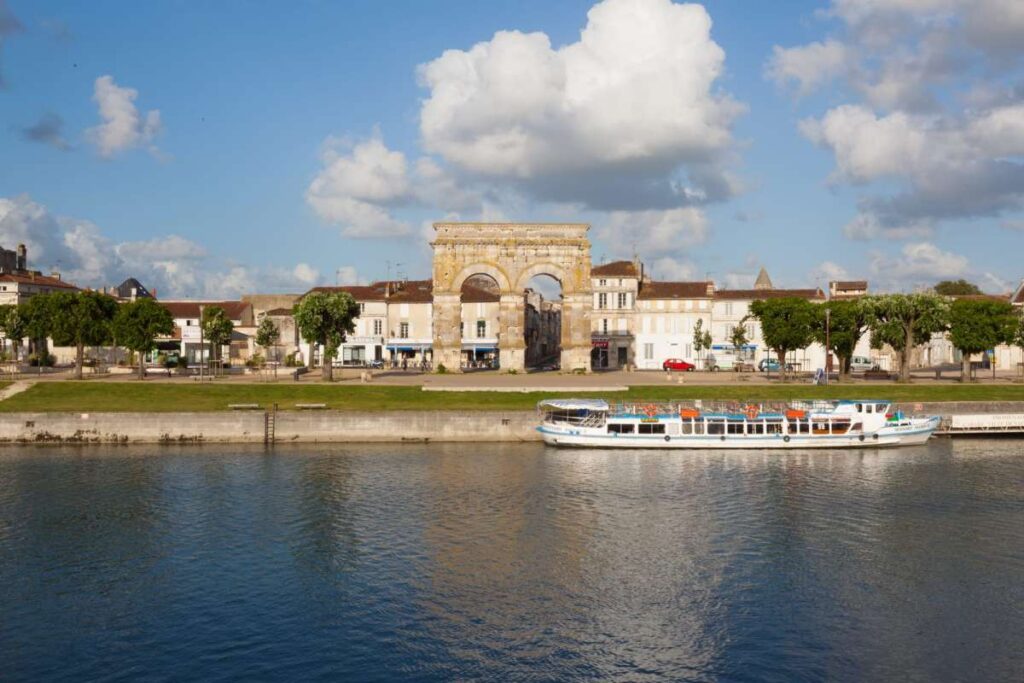
Image from Unlimphotos. Panoramic view from the city of Saintes in the French region of Charente, with the Charente River.
Angoulême may be known for its art and architecture, but it also opens the door to some of southwestern France’s most scenic and culturally rich corners. The surrounding Charente countryside is gentle and green, ideal for slow bike, kayak, or car exploration.
Within an hour’s reach, historic towns, elegant castles, and rolling vineyards offer day trips that balance the urban experience with nature and heritage.
Cycling or Kayaking the Charente Valley
The Charente River winds gracefully through the landscape, and Angoulême is perfectly positioned for exploring it. Paved cycling paths follow the riverbanks, passing through quiet hamlets, open fields, and shaded woodlands. The route is flat and well-marked, making it ideal even for casual riders.
For a different pace, kayaking the river offers a peaceful way to take in the scenery. The water is calm, and rental spots are available in and around the city.
Along the way, herons and kingfishers are familiar sights, and the occasional riverside château or Romanesque bridge adds a touch of historical intrigue to the natural setting.
Distillery Tours in Cognac
About 45 minutes west of Angoulême lies Cognac, the town that gave its name to one of France’s most iconic spirits. A visit here is both educational and sensory. Major houses like Hennessy, Rémy Martin, and Martell offer guided tours that walk through the entire production process—from vineyards and copper stills to the aging cellars where barrels sit for decades.
Tastings are usually included, often paired with chocolates or cheeses to highlight the subtlety of flavors. These aren’t tourist traps but serious introductions to a centuries-old craft. Many distilleries offer art exhibits or historic archives, adding cultural context to every pour.
Château de La Rochefoucauld
Just a 30-minute drive from Angoulême, this privately owned castle is one of the most elegant in the region. The Château de La Rochefoucauld has been in the same family for over a thousand years, evident in the meticulous preservation of the building and its contents.
Visitors can explore grand halls, a Renaissance staircase designed by Leonardo da Vinci’s school, and furnished rooms that feel lived-in rather than staged.
The onsite library, filled with antique volumes, and the costume room, where guests can try on period clothing, make the experience interactive and personal. The surrounding village is quiet and picturesque—a worthy destination in its own right.
When to Visit & How to Get Around
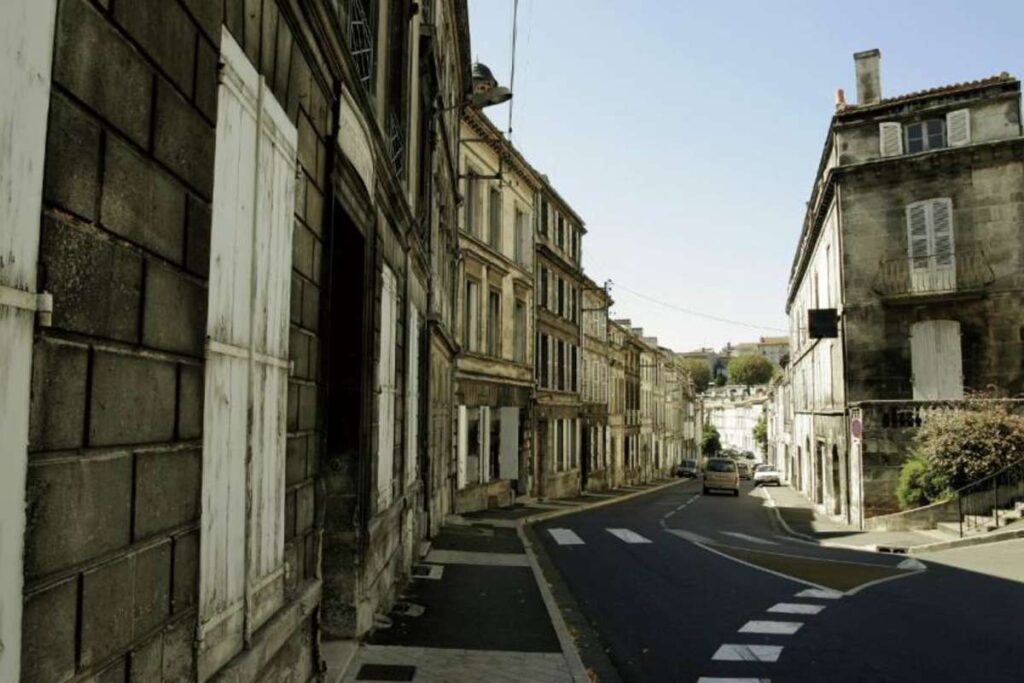
Image from Canva. A quiet street of Angouleme, France
Angoulême has a rhythm—quietly vibrant, rarely hurried—and timing a visit well can make all the difference. While it’s a year-round destination, certain seasons offer a more rewarding mix of weather, atmosphere, and events.
Once there, navigating the town and its surroundings is refreshingly straightforward thanks to its walkable size and well-connected transport options.
Best Seasons to Visit
Spring and early autumn are the sweet spots. From April to June, the weather is mild (typically 15–25°C), the gardens and countryside are in full bloom, and the city feels relaxed without being sleepy. September and October bring golden light, harvest flavors, and fewer tourists, making it ideal for those who prefer a quieter cultural experience.
January is the peak for those interested in the Angoulême International Comics Festival. The city buzzes with energy, and hotel availability becomes limited—planning well in advance is essential. While the weather may be brisk, the atmosphere more than makes up for it.
Getting There
Angoulême is well connected via France’s high-speed TGV rail network. The trip from Paris takes just over two hours and is a quick 35–40 minutes from Bordeaux. The train station sits at the base of the hill, with shuttle buses and taxis ready to bring travelers into the old town in under 10 minutes.
For those driving, Angoulême is easily accessible via the A10 and N10 routes, with ample parking just outside the pedestrian zones. Its central location also makes it a strategic base for exploring the wider Charente and Nouvelle-Aquitaine regions.
Getting Around the City
The historic center is compact and best explored on foot. Streets wind through tightly-knit neighborhoods, and key attractions—museums, markets, restaurants—are all within easy walking distance. A reliable local bus network covers most needs for longer trips or outlying areas.
Bike rentals are available through both independent shops and seasonal sharing schemes. The riverside paths and surrounding countryside are especially well-suited for cycling. Taxis are available, but are rarely essential unless traveling to more remote villages or arriving late at night.
Château de Lasfonds – A Peaceful Retreat Just Outside Angoulême
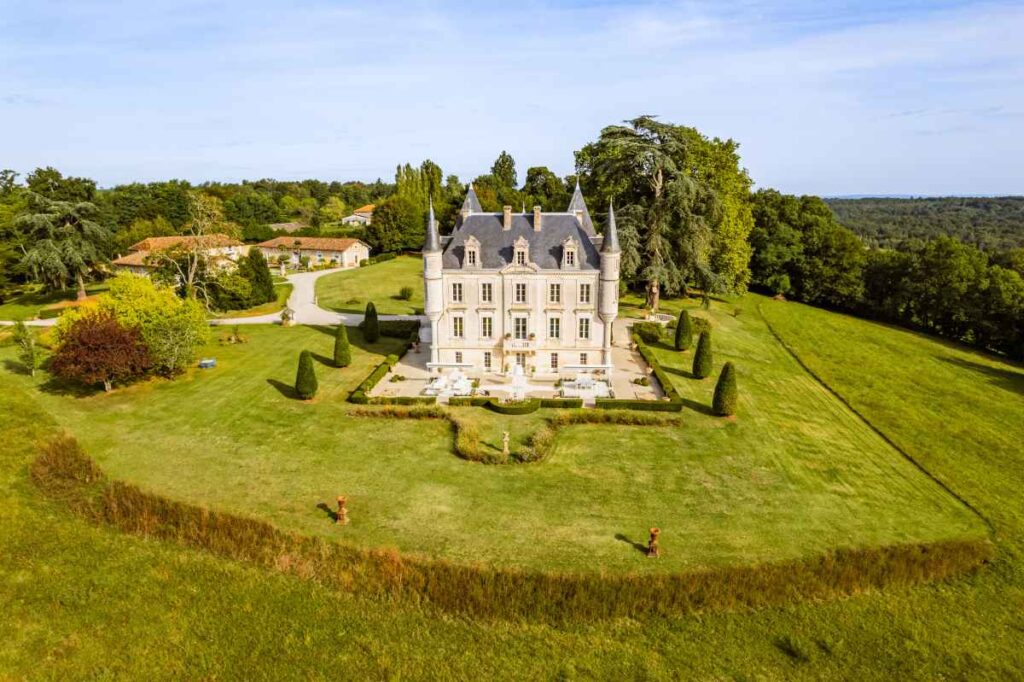
Chateau de Lasfonds
For those extending their stay in the region or looking for a unique base just beyond Angoulême, Château de Lasfonds offers a quiet, well-connected escape in the Dordogne countryside.
About 35 minutes from the city by car, this historic property blends classic French château character with modern comfort—ideal for small group stays, creative retreats, or milestone celebrations.
A Private Setting for Meaningful Moments
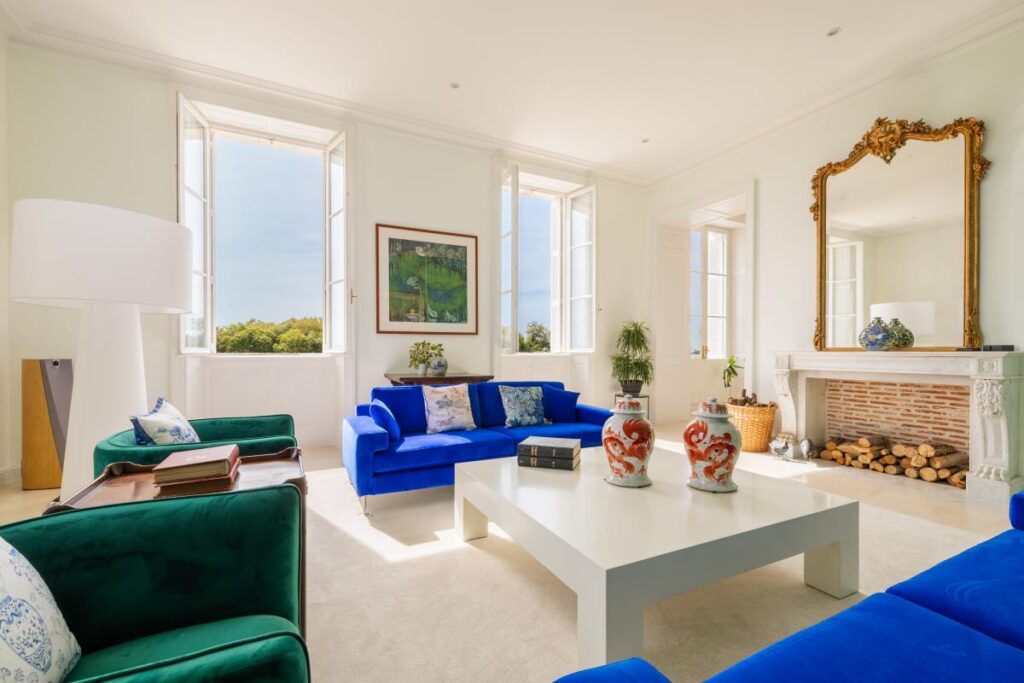
Interior of Chateau de Lasfonds
Set on 6.5 hectares of private grounds, the château is designed for connection and comfort. It’s a natural fit for family celebrations, low-key corporate retreats, or small-group escapes that call for space, calm, and character. The atmosphere is peaceful and personal, with no neighboring properties in sight—just gardens, open skies, and the rhythm of the countryside.
Where Historic Charm Meets Modern Ease
The estate includes the main château and several outbuildings, all updated with modern amenities. Guests can expect floor heating, reversible air conditioning, fully equipped kitchens, and a heated pool for the warmer months.
A gym, a games room, and adaptable indoor and outdoor areas work equally well for casual dinners or structured sessions. The art salon and office space can accommodate meetings or workshops, adding function to the château’s relaxed ambiance.
Close Enough to Reach, Far Enough to Disconnect
Though it feels remote, the château is well connected. It’s a 2.5-hour TGV ride from Paris to Angoulême, followed by a short drive through scenic backroads. Regional airports in Bordeaux, Limoges, and Bergerac offer more options for international visitors. Car rental is highly recommended for exploring the surrounding villages and countryside.
Château de Lasfonds doesn’t aim to impress with grandeur—it invites with warmth, privacy, and a sense of place. It’s a quiet escape for those who value simplicity, space, and meaningful time together.
Ready to Experience It?
Whether planning a quiet getaway or an intimate gathering, Château de Lasfonds offers the space, comfort, and setting to make it unforgettable.
Book your stay here or contact us directly to discuss availability and tailor your visit. The château team will guide you through each step—from planning to arrival—ensuring a personal and seamless stay.
FAQs about Top Things to Do in Angoulême
Angoulême is internationally known as the comic book capital of France, celebrated for its large-scale street art and its prestigious International Comics Festival. The city is admired for its medieval ramparts, Romanesque cathedral, and scenic views over the Charente River.
Angoulême is officially a city, serving as the capital of the Charente department in southwestern France. Despite its compact, walkable size, it has a rich urban character shaped by centuries of history and a thriving creative community.
There’s no shortage of meaningful things to do in Angoulême, whether diving into its artistic heritage or enjoying the region’s cuisine and countryside. Top experiences in Angoulême include:
- Visiting the Cité Internationale de la Bande Dessinée et de l’Image
- Exploring the fresco trail of painted comic murals
- Walking the historic ramparts for panoramic river views
- Touring the Angoulême Cathedral and Town Hall
- Discovering regional culture at the Musée d’Angoulême
- Browsing and tasting local produce at Les Halles market
For a countryside escape, the nearby Château de Lasfonds offers a quiet and elegant retreat, just 35 minutes from the city.
Absolutely. Angoulême offers a unique blend of art, history, and small-city charm that feels authentic and relaxed. It’s ideal for travelers looking to explore beyond France’s more crowded destinations, and it pairs cultural depth with natural beauty and excellent food.
In addition to city highlights, nearby attractions include:
- Château de Lasfonds, a peaceful 18-guest estate perfect for group stays, events, or retreats
- The Charente Valley is ideal for biking and kayaking
- The town of Cognac, famous for its distilleries and tastings
These spots make Angoulême an excellent base for exploring the broader Charente and Dordogne regions.
Each January, Angoulême hosts the Festival International de la Bande Dessinée, one of the world’s leading comic book festivals. The event draws around 6,000 professionals and over 200,000 visitors from across the globe. The city transforms into a creative hub with exhibitions, talks, signings, and installations. It’s held annually during the last weekend of January and is a must for fans of visual storytelling.
Angoulême is well connected by France’s high-speed TGV train network, making it easy to reach from Paris in just over 2.5 hours. It’s also within driving distance of several airports, including Bordeaux, Limoges, and Bergerac. The city center is a quick taxi or bus ride from the train station.
Yes, the city center is very walkable. Most key attractions—like the cathedral, comic museum, and fresco trail—are within a compact, hilltop area. Comfortable shoes are recommended, especially when exploring cobbled streets and the elevated ramparts.
The ideal time to visit is from April to October, when the weather is mild and most attractions are in full swing. Late January is a special time for culture lovers due to the International Comics Festival. Spring and early autumn offer the best balance of good weather and fewer crowds.
Yes, the surrounding countryside offers several peaceful options. One standout is Château de Lasfonds, a beautifully restored estate about 35 minutes away. It’s well-suited for small group stays, private events, and those seeking a quiet retreat with easy access to the city.
Angoulême and the wider Charente region are known for rustic French dishes like grillon charentais (a pork pâté), fresh goat cheeses, and high-quality local wines and Pineau des Charentes. The covered market, Les Halles, is the best place to explore these regional flavors firsthand.

